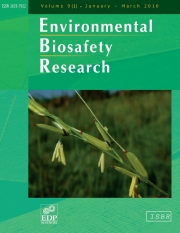Crossref Citations
This article has been cited by the following publications. This list is generated based on data provided by
Crossref.
Chandler, Stephen
and
Dunwell, Jim M.
2008.
Gene Flow, Risk Assessment and the Environmental Release of Transgenic Plants.
Critical Reviews in Plant Sciences,
Vol. 27,
Issue. 1,
p.
25.
Kim, Chang-Gi
Kim, Dae In
Kim, Hyo-Jeong
Park, Ji Eun
Lee, Bumkyu
Park, Kee Woong
Jeong, Soon-Chun
Choi, Kyung Hwa
An, Joo Hee
Cho, Kang-Hyun
Kim, Young Soon
and
Kim, Hwan Mook
2009.
Assessment of Gene Flow from Genetically Modified Anthracnose-Resistant Chili Pepper (Capsicum annuum L.) to a Conventional Crop.
Journal of Plant Biology,
Vol. 52,
Issue. 3,
p.
251.
Wang, Tianyu
Shi, Yunsu
Li, Yu
and
Darmency, Henri
2009.
Testing coexistence and genetic containment for an autogamous crop.
Transgenic Research,
Vol. 18,
Issue. 5,
p.
809.
MIZUGUTI, AKI
YOSHIMURA, YASUYUKI
and
MATSUO, KAZUHITO
2009.
Flowering phenologies and natural hybridization of genetically modified and wild soybeans under field conditions.
Weed Biology and Management,
Vol. 9,
Issue. 1,
p.
93.
Zhao, Ru
Xia, Hanbing
and
Lu, Bao‐rong
2009.
Fine‐scale genetic structure enhances biparental inbreeding by promoting mating events between more related individuals in wild soybean (Glycine soja; Fabaceae) populations.
American Journal of Botany,
Vol. 96,
Issue. 6,
p.
1138.
Rehbinder, Eckard
Rehbinder, E.
Engelhard, M.
Hagen, K.
Jørgensen, R. B.
Pardo-Avellaneda, R.
Schnieke, A.
and
Thiele, F.
2009.
Pharming.
Vol. 35,
Issue. ,
p.
73.
YAMAGUCHI, Hirofumi
2009.
KAGAKU TO SEIBUTSU,
Vol. 47,
Issue. 12,
p.
874.
Shimamura, Satoshi
Iimura, Keiji
Takamizo, Tadashi
Ishimoto, Masao
and
Hajika, Makita
2010.
Effects of Low Temperature before Flowering Stage on Natural Out-Crossing Rates in Soybean.
Japanese Journal of Crop Science,
Vol. 79,
Issue. 3,
p.
316.
Imura, Osamu
Shi, Kun
Iimura, Keiji
and
Takamizo, Tadashi
2010.
Assessing the effects of cultivating genetically modified glyphosate-tolerant varieties of soybeans (Glycine max(L.) Merr.) on populations of field arthropods.
Environmental Biosafety Research,
Vol. 9,
Issue. 2,
p.
101.
Mizuguti, Aki
Ohigashi, Kentaro
Yoshimura, Yasuyuki
Kaga, Akito
Kuroda, Yosuke
and
Matsuo, Kazuhito
2010.
Hybridization between GM soybean (Glycine max(L.) Merr.) and wild soybean (Glycine sojaSieb. et Zucc.) under field conditions in Japan.
Environmental Biosafety Research,
Vol. 9,
Issue. 1,
p.
13.
2011.
Scientific Opinion on application (EFSA‐GMO‐BE‐2010‐79) for the placing on the market of insect resistant genetically modified soybean MON 87701 for food and feed uses, import and processing under Regulation (EC) No 1829/2003 from Monsanto.
EFSA Journal,
Vol. 9,
Issue. 7,
Yoshimura, Yasuyuki
2011.
Wind tunnel and field assessment of pollen dispersal in Soybean [Glycine max (L.) Merr.].
Journal of Plant Research,
Vol. 124,
Issue. 1,
p.
109.
Jhala, A J
Bhatt, H
Topinka, K
and
Hall, L M
2011.
Pollen-mediated gene flow in flax (Linum usitatissimum L.): can genetically engineered and organic flax coexist?.
Heredity,
Vol. 106,
Issue. 4,
p.
557.
2012.
Scientific opinion on application (EFSA-GMO-NL-2009-73) for the placing on the market of insect-resistant and herbicide-tolerant genetically modified soybean MON 87701 × MON 89788 for food and feed uses, import and processing under Regulation (EC) No 1829.
EFSA Journal,
Vol. 10,
Issue. 2,
p.
2560.
2012.
Scientific Opinion on an application (EFSA‐GMO‐NL‐2005‐24) for the placing on the market of the herbicide tolerant genetically modified soybean 40‐3‐2 for cultivation under Regulation (EC) No 1829/2003 from Monsanto.
EFSA Journal,
Vol. 10,
Issue. 6,
Pereira, Welison Andrade
Sávio, Filipe Luis
Dias, Denise Cunha Fernandes dos Santos
Cruz, Cosme Damião
and
Borém, Aluízio
2012.
Fluxo gênico recíproco entre cultivares de soja convencional e geneticamente modificada.
Pesquisa Agropecuária Brasileira,
Vol. 47,
Issue. 2,
p.
227.
2012.
Scientific Opinion on application (EFSA‐GMO‐NL‐2010‐78) for the placing on the market of herbicide‐tolerant, increased oleic acid genetically modified soybean MON 87705 for food and feed uses, import and processing under Regulation (EC) No 1829/2003 from Monsanto.
EFSA Journal,
Vol. 10,
Issue. 10,
2013.
Scientific Opinion on application EFSA‐GMO‐NL‐2011‐93 for the placing on the market of the herbicide‐tolerant genetically modified soybean MON 87708 for food and feed uses, import and processing under Regulation (EC) No 1829/2003 from Monsanto.
EFSA Journal,
Vol. 11,
Issue. 10,
de O. Milfont, Marcelo
Rocha, Epifania Emanuela M.
Lima, Afonso Odério N.
and
Freitas, Breno M.
2013.
Higher soybean production using honeybee and wild pollinators, a sustainable alternative to pesticides and autopollination.
Environmental Chemistry Letters,
Vol. 11,
Issue. 4,
p.
335.
Scorza, Ralph
Kriss, Alissa B.
Callahan, Ann M.
Webb, Kevin
Demuth, Mark
Gottwald, Tim
and
Vinatzer, Boris Alexander
2013.
Spatial and Temporal Assessment of Pollen- and Seed-Mediated Gene Flow from Genetically Engineered Plum Prunus domestica.
PLoS ONE,
Vol. 8,
Issue. 10,
p.
e75291.

